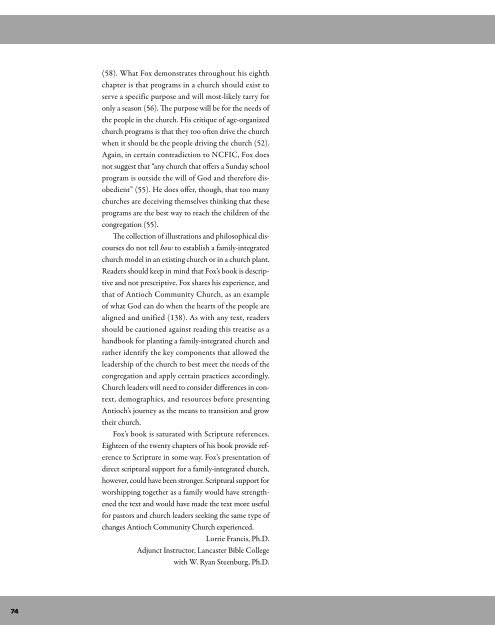here - The Southern Baptist Theological Seminary
here - The Southern Baptist Theological Seminary
here - The Southern Baptist Theological Seminary
You also want an ePaper? Increase the reach of your titles
YUMPU automatically turns print PDFs into web optimized ePapers that Google loves.
74<br />
(58). What Fox demonstrates throughout his eighth<br />
chapter is that programs in a church should exist to<br />
serve a specific purpose and will most-likely tarry for<br />
only a season (56). <strong>The</strong> purpose will be for the needs of<br />
the people in the church. His critique of age-organized<br />
church programs is that they too often drive the church<br />
when it should be the people driving the church (52).<br />
Again, in certain contradiction to NCFIC, Fox does<br />
not suggest that “any church that offers a Sunday school<br />
program is outside the will of God and t<strong>here</strong>fore disobedient”<br />
(55). He does offer, though, that too many<br />
churches are deceiving themselves thinking that these<br />
programs are the best way to reach the children of the<br />
congregation (55).<br />
<strong>The</strong> collection of illustrations and philosophical discourses<br />
do not tell how to establish a family-integrated<br />
church model in an existing church or in a church plant.<br />
Readers should keep in mind that Fox’s book is descriptive<br />
and not prescriptive. Fox shares his experience, and<br />
that of Antioch Community Church, as an example<br />
of what God can do when the hearts of the people are<br />
aligned and unified (138). As with any text, readers<br />
should be cautioned against reading this treatise as a<br />
handbook for planting a family-integrated church and<br />
rather identify the key components that allowed the<br />
leadership of the church to best meet the needs of the<br />
congregation and apply certain practices accordingly.<br />
Church leaders will need to consider differences in context,<br />
demographics, and resources before presenting<br />
Antioch’s journey as the means to transition and grow<br />
their church.<br />
Fox’s book is saturated with Scripture references.<br />
Eighteen of the twenty chapters of his book provide reference<br />
to Scripture in some way. Fox’s presentation of<br />
direct scriptural support for a family-integrated church,<br />
however, could have been stronger. Scriptural support for<br />
worshipping together as a family would have strengthened<br />
the text and would have made the text more useful<br />
for pastors and church leaders seeking the same type of<br />
changes Antioch Community Church experienced.<br />
Lorrie Francis, Ph.D.<br />
Adjunct Instructor, Lancaster Bible College<br />
with W. Ryan Steenburg, Ph.D.
















